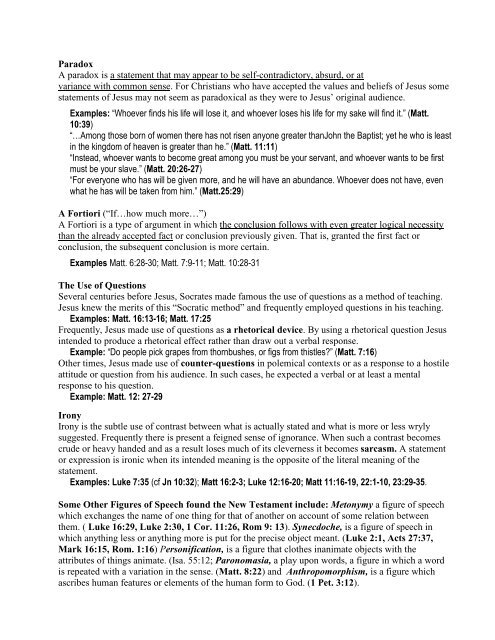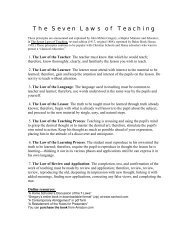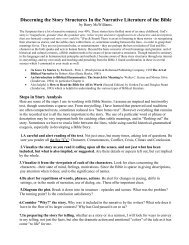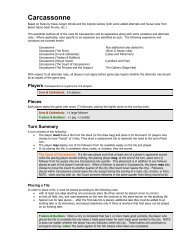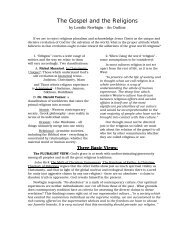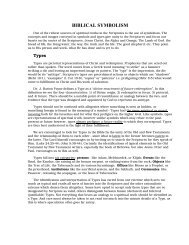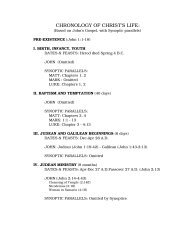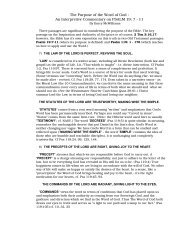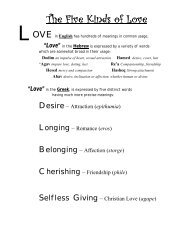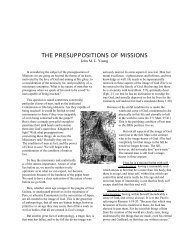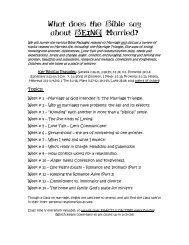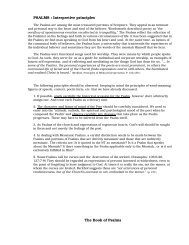Jesus' Use of Figurative Language - Eldrbarry's Story Telling Page
Jesus' Use of Figurative Language - Eldrbarry's Story Telling Page
Jesus' Use of Figurative Language - Eldrbarry's Story Telling Page
Create successful ePaper yourself
Turn your PDF publications into a flip-book with our unique Google optimized e-Paper software.
Paradox<br />
A paradox is a statement that may appear to be self-contradictory, absurd, or at<br />
variance with common sense. For Christians who have accepted the values and beliefs <strong>of</strong> Jesus some<br />
statements <strong>of</strong> Jesus may not seem as paradoxical as they were to Jesus’ original audience.<br />
Examples: “Whoever finds his life will lose it, and whoever loses his life for my sake will find it.” (Matt.<br />
10:39)<br />
“…Among those born <strong>of</strong> women there has not risen anyone greater thanJohn the Baptist; yet he who is least<br />
in the kingdom <strong>of</strong> heaven is greater than he.” (Matt. 11:11)<br />
“Instead, whoever wants to become great among you must be your servant, and whoever wants to be first<br />
must be your slave.” (Matt. 20:26-27)<br />
“For everyone who has will be given more, and he will have an abundance. Whoever does not have, even<br />
what he has will be taken from him.” (Matt.25:29)<br />
A Fortiori (“If…how much more…”)<br />
A Fortiori is a type <strong>of</strong> argument in which the conclusion follows with even greater logical necessity<br />
than the already accepted fact or conclusion previously given. That is, granted the first fact or<br />
conclusion, the subsequent conclusion is more certain.<br />
Examples Matt. 6:28-30; Matt. 7:9-11; Matt. 10:28-31<br />
The <strong>Use</strong> <strong>of</strong> Questions<br />
Several centuries before Jesus, Socrates made famous the use <strong>of</strong> questions as a method <strong>of</strong> teaching.<br />
Jesus knew the merits <strong>of</strong> this “Socratic method” and frequently employed questions in his teaching.<br />
Examples: Matt. 16:13-16; Matt. 17:25<br />
Frequently, Jesus made use <strong>of</strong> questions as a rhetorical device. By using a rhetorical question Jesus<br />
intended to produce a rhetorical effect rather than draw out a verbal response.<br />
Example: “Do people pick grapes from thornbushes, or figs from thistles?” (Matt. 7:16)<br />
Other times, Jesus made use <strong>of</strong> counter-questions in polemical contexts or as a response to a hostile<br />
attitude or question from his audience. In such cases, he expected a verbal or at least a mental<br />
response to his question.<br />
Example: Matt. 12: 27-29<br />
Irony<br />
Irony is the subtle use <strong>of</strong> contrast between what is actually stated and what is more or less wryly<br />
suggested. Frequently there is present a feigned sense <strong>of</strong> ignorance. When such a contrast becomes<br />
crude or heavy handed and as a result loses much <strong>of</strong> its cleverness it becomes sarcasm. A statement<br />
or expression is ironic when its intended meaning is the opposite <strong>of</strong> the literal meaning <strong>of</strong> the<br />
statement.<br />
Examples: Luke 7:35 (cf Jn 10:32); Matt 16:2-3; Luke 12:16-20; Matt 11:16-19, 22:1-10, 23:29-35.<br />
Some Other Figures <strong>of</strong> Speech found the New Testament include: Metonymy a figure <strong>of</strong> speech<br />
which exchanges the name <strong>of</strong> one thing for that <strong>of</strong> another on account <strong>of</strong> some relation between<br />
them. ( Luke 16:29, Luke 2:30, 1 Cor. 11:26, Rom 9: 13). Synecdoche, is a figure <strong>of</strong> speech in<br />
which anything less or anything more is put for the precise object meant. (Luke 2:1, Acts 27:37,<br />
Mark 16:15, Rom. 1:16) Personification, is a figure that clothes inanimate objects with the<br />
attributes <strong>of</strong> things animate. (Isa. 55:12; Paronomasia, a play upon words, a figure in which a word<br />
is repeated with a variation in the sense. (Matt. 8:22) and Anthropomorphism, is a figure which<br />
ascribes human features or elements <strong>of</strong> the human form to God. (1 Pet. 3:12).


